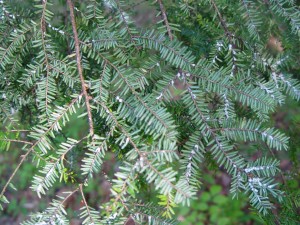Proper care of hemlock trees is important for their survival. Hot dry summer weather appears to slow population growth. During periods of severe drought, shallow rooted hemlock trees should be irrigated. Prune dead and dying branches from trees to promote new growth. Also, limit the amount of nitrogen fertilizers to hemlock(s), as it promotes heavier woolly adelgid populations.
Cultural practices may reduce numbers of adelgids in hemlocks. Pets, as well as birds, squirrels and deer, may transport adelgids from infested to healthy hemlocks. Refrain from moving infested plants, logs, firewood or bark chips onto an uninfested property. Clean your auto and camping tents after returning from woodlands and recreational areas. Wash off pruning equipment after working in infested trees.
Two Japanese and two western North American hemlock species are much more resistant to hemlock woolly adelgid than are their eastern North American counterparts. Of these four resistant species, the western hemlock (T. heterophylla) is most similar to eastern hemlock in appearance, growth form, and utility. Although adelgids do infest these resistant species, they seldom reach densities high enough to cause injury.
Entomologists are also releasing predator insects which hopefully may add hemlock woolly adelgids to their diet.
Credit: Special thank you for information supplied by NC State University Extension.


 Posted in
Posted in 
